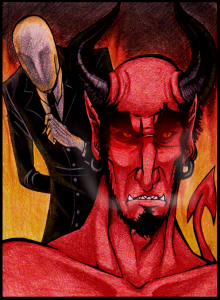By now you have surely heard that two 12 year old girls in Wisconsin lured one of their friends into the woods where they stabbed the victim 19 times and left her for dead. And you have also surely heard that the girls did this because they wanted to curry favor with a fictional internet character known as Slenderman.
This horrific event has of course prompted all the usual hand-wringing about the ailments of American culture. For many pundits, this hand-wringing is better described as national soul-searching. I mean this literally and not figuratively. The Chicago Tribune asks: “What kind of culture produced those two 12-year old Wisconsin girls charged with stabbing a classmate 19 times?” The simple answer: “Our culture.” The Tribune describes this (Christian) culture as one beholden to fantasy but bereft of religion:
It is a culture that has fallen in love with magic and fantasy. It is a culture that takes fantasy symbols of evil — the vampire, the witch — and transforms them into heroes of great virtue. It is a culture where dark magic is celebrated, but religion is considered bothersome. We reap what we sow. Once, Dracula would take our immortal souls. These days, souls aren’t discussed much, perhaps because the mention of souls will offend somebody.
The Tribune then tells us, with no apparent sense of irony or dissonance, that those of us who can “distinguish between fantasy and reality” know that Slenderman is not real. Souls, however, are.
The Milwaukee Journal Sentinel similarly wonders “what went wrong.” Again, the diagnosis is cryptically framed in Christian terms:
“The bad part of me” for 12-year-old Anissa Weier allegedly erupted in violence and became headlines. Just weeks earlier, her friend, Morgan Geyser, is reported to have drawn a picture of the fictional online character Slender Man on a napkin at a restaurant, and her obsession seemed amusing. Frightening things happen to “the bad part” of us when our psyches confuse fantasy and reality.
There are dark parts of the soul in each and every one of us. This is the longstanding historic Christian view of human nature. Unpleasant but true. The darkness can be simple ignorance, solved by bringing more light into the situation. For some, darkness has become the living space for evil. Another kind of darkness is delusion, unpredictable and dangerous. If the allegations are true, the suspects seem to have been deluded in that they utterly confused reality and fantasy.
From this supremely unironic point of view, the problem is that some Americans (presumably the lapsed Christians and non-Christians) are “deluded” and unable to distinguish between “reality” and “fantasy.” For the Milwaukee Journal Sentinel, the suggested fix is to tend to our “souls” and “take our spiritual lives seriously.”
It seems not to have occurred to these writers (and many more like them) that the problem here is that American culture, predominantly Christian, takes invisible agents all too seriously. So seriously, in fact, that many Americans cannot distinguish between fantasy and reality.
Is it any wonder that these 12 year old girls from Wisconsin believed that Slenderman is real? How does Slenderman differ from the Holy Ghost or Spirit? The difference, according to Pastor Robin Swope, is that Slenderman is a demon. In his book Slenderman: From Fiction to Fact, Pastor Swope tells us that Slenderman is not just fantasy or myth: he is an active demonic force. For those who think that Swope is a crackpot who can’t distinguish between fantasy and reality, let’s consider his credentials:
Pastor Swope has been a Christian Minister for more than 20 years in both Mainline and Evangelical Denominations. He holds a B.A. in Biblical Literature from Nyack College and an M.Div. In Pastoral Ministry with an emphasis on Pastoral Counseling from Alliance Theological Seminary. He has served as a Missionary to Burkina Faso, and has Ministered to the homeless in New York City’s Hell’s Kitchen. He is currently the Pastor of St.Paul’s United Church of Christ in Erie, Pennsylvania.
Given that Pastor Swope and millions of other American Christians believe that Slenderman actually exists and is a spirit or demon, why should we expect two 12 year old girls from Wisconsin to believe any differently?
When the Chicago Tribune claimed that “our culture” was to blame for these girls’ inability to distinguish between “fantasy and reality,” it got things only partially right. The Tribune should have said: “our Christian culture.” It is a culture in which the majority of people believe that God, Satan, angels, and demons actually exist. America is a spirit-filled place, where invisible agents run rampant, making it difficult even for adults to distinguish between fantasy and reality. How, in this milieu, can we hold these 12 year old girls to a different standard (or call them “deluded” and “mentally ill”) for believing in Slenderman?


